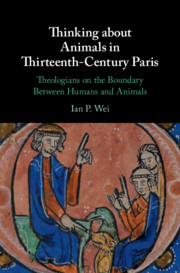 Thinking about Animals in Thirteenth-Century Paris
Thinking about Animals in Thirteenth-Century Paris Conclusion
Published online by Cambridge University Press: 07 August 2020
Summary
When Parisian theologians of the thirteenth century wrote about animals and the similarities and differences between animals and humans, there was great variety and richness in their work. While ‘the paradigm of the boundary’ persisted, ‘the plurality and density of medieval thought about animals’ that Susan Crane so brilliantly identified in vernacular literature was equally characteristic of theological texts written in Latin.1 With reference to bestiaries, Crane observed that ‘With ratio as their distinguishing feature, humans are crucially differentiated from other animals; with ratio even slightly shared out among them, animal difference is shot through with similitude’, and it is clear that for the masters ‘animal difference’ was indeed ‘shot through with similitude’.2 Moreover, while historians of philosophy like Anselm Oelze have, with immense precision and eloquence, explained the different ways in which some medieval scholars attributed various ‘rational processes’ to animals, it is also apparent that preoccupation with and desire to explore similarity between animals and humans extended into many different areas of the theologians’ endeavours, including, as we have seen, discussions of creation, the fall, divine providence, the heavens, angels and demons, virtues and passions, to list just some of the topics that prompted theologians to assess continuity between the animal and the human.
- Type
- Chapter
- Information
- Thinking about Animals in Thirteenth-Century ParisTheologians on the Boundary Between Humans and Animals, pp. 201 - 208Publisher: Cambridge University PressPrint publication year: 2020
